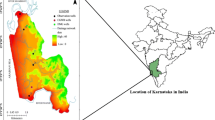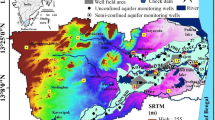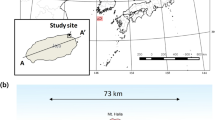Abstract
Assessing sustainability of coastal groundwater is significant for groundwater management as coastal groundwater is vulnerable to over-exploitation and contamination. To address the issues of serious groundwater level drawdown and potential seawater intrusion risk of a multi-layered coastal aquifer system in Zhanjiang, China, this paper presents a numerical modelling study to research groundwater sustainability of this aquifer system. The transient modelling results show that the groundwater budget was negative (\(-3826\times 10^{4}\) to \(-4502\times 10^{4 }\,\hbox {m}^{3}/\hbox {a}\)) during the years 2008–2011, revealing that this aquifer system was over-exploited. Meanwhile, the groundwater sustainability was assessed by evaluating the negative hydraulic pressure area (NHPA) of the unconfined aquifer and the groundwater level dynamic and flow velocity of the offshore boundaries of the confined aquifers. The results demonstrate that the Nansan Island is most influenced by NHPA and that the local groundwater should not be exploited. The results also suggest that, with the current groundwater exploitation scheme, the sustainable yield should be \(1.784\times 10^{8}\, \hbox {m}^{3}/\hbox {a}\) (i.e., decreased by 20% from the current exploitation amount). To satisfy public water demands, the 20% decrease of the exploitation amount can be offset by the groundwater sourced from the Taiping groundwater resource field. These results provide valuable guidance for groundwater management of Zhanjiang.

















Similar content being viewed by others
References
Alfaro P, Liesch T and Goldscheider N 2017 Modelling groundwater over-extraction in the southern Jordan Valley with scarce data; Hydrogeol. J. 25(5) 1319–1340, doi: 10.1007/s10040-017-1535-y.
Alley W M and Leake S A 2004 The journey from safe yield to sustainability; Groundwater 42 12–16.
Ayvaz M T and Karahan H 2008 A simulation/optimization model for the identification of unknown groundwater well locations and pumping rates; J. Hydrol. 357 76–92.
Barazzuoli P, Nocchi M, Rigati R and Salleolini M 2008 A conceptual and numerical model for groundwater management: A case study on a coastal aquifer in southern Tuscany; Hydrogeol. J. 16 1557–1576.
Barlow P M and Reichard E G 2010 Saltwater intrusion in coastal regions of North America; Hydrogeol. J. 18 247–260.
Chandio A S, Lee T S and Mirjat M S 2012 The extent of waterlogging in the lower Indus Basin (Pakistan) – A modeling study of groundwater levels; J. Hydrol. 426–427 103–111.
Chuang M-H and Yeh H-D 2007 An analytical solution for the head distribution in a tidal leaky confined aquifer extending an infinite distance under the sea; Adv. Water Resour. 30 439–445.
De Filippis G, Foglia L, Giudici M, Mehl S, Margiotta S and Negri S L 2016 Seawater intrusion in karstic, coastal aquifers: Current challenges and future scenarios in the Taranto area (southern Italy); Sci. Total Environ. 573 1340–1351.
Dogrul E C, Kadir T N, Brush C F and Chung F I 2016 Linking groundwater simulation and reservoir system analysis models: The case for California’s Central Valley; Environ. Model. Softw. 77 168–182.
El-Kadi AI, Tillery S, Whittier R B, Hagedorn B, Mair A, Ha K and Koh G-W 2014 Assessing sustainability of groundwater resources on Jeju Island, South Korea, under climate change, drought, and increased usage; Hydrogeol. J. 22 625–642.
Eshtawi T, Evers M, Tischbein B and Diekkrüger B 2016 Integrated hydrologic modeling as a key for sustainable urban water resources planning; Water Res. 101 411–428.
Ferguson G and Gleeson T 2012 Vulnerability of coastal aquifers to climate change and groundwater use; Nat. Clim. Change 2 342–345.
First Hydrogeological Team, Guangdong Geological Bureau 2009a Report of regional hydrogeologic investigation of Donghai island (in Chinese).
First Hydrogeological Team, Guangdong Geological Bureau 2009b Monitoring report of the groundwater dynamics of Zhanjiang city in 2008 (in Chinese).
First Hydrogeological Team, Guangdong Geological Bureau 2010 Monitoring report of the groundwater dynamics of Zhanjiang city in 2009 (in Chinese).
First Hydrogeological Team, Guangdong Geological Bureau 2011 Monitoring report of the groundwater dynamics of Zhanjiang city in 2010 (in Chinese).
First Hydrogeological Team, Guangdong Geological Bureau 2012 Monitoring report of the groundwater dynamics of Zhanjiang city in 2011 (in Chinese).
Ghassemi F, Close A and Kellett J R 1997 Numerical models for the management of land and water resources salinization; Math. Comput. Simulat. 43 323–329.
Gleeson T, Alley W M, Allen D M, Sophocleous M A, Zhou Y, Taniguchi M and VanderSteen J 2012 Towards sustainable groundwater use: Setting long-term goals, backcasting, and managing adaptively; Groundwater 50 19–26.
Green N R and MacQuarrie K T B 2014 An evaluation of the relative importance of the effects of climate change and groundwater extraction on seawater intrusion in coastal aquifers in Atlantic Canada; Hydrogeol. J. 22 609–623.
Heydari F, Saghafian B and Delavar M 2016 Coupled quantity-quality simulation-optimization model for conjunctive surface-groundwater use; Water Resour. Manag. 30 4381–4397
Jang C S, Chen C F, Liang C P and Chen J S 2016 Combining groundwater quality analysis and a numerical flow simulation for spatially establishing utilization strategies for groundwater and surface water in the Pingtung Plain; J. Hydrol. 533 541–556.
Jhorar R K, Smit A A M F R and Roest C W J 2009 Assessment of alternative water management options for irrigated agriculture; Agric. Water Manag. 96 975–981.
Kalf F R P and Woolley D R 2005 Applicability and methodology of determining sustainable yield in groundwater systems; Hydrogeol. J. 13 295–312.
Knowling M J, Werner A D and Herckenrath D 2015 Quantifying climate and pumping contributions to aquifer depletion using a highly parameterised groundwater model: Uley South Basin (South Australia); J. Hydrol. 523 515–530.
Kourakos G and Mantoglou A 2011 Simulation and multi-objective management of coastal aquifers in semi-arid regions; Water Resour. Manag. 25(4) 1063–1074.
Kourakos G and Mantoglou A 2013 Development of a multi-objective optimization algorithm using surrogate models for coastal aquifer management; J. Hydrol. 479 13–23.
Lathashri U A and Mahesha A 2016 Groundwater sustainability assessment in coastal aquifers; J. Earth Syst. Sci. 125 1103–1118.
Lemieux J-M, Hassaoui J, Molson J, Therrien R, Therrien P, Chouteau M and Ouellet M 2015 Simulating the impact of climate change on the groundwater resources of the Magdalen Islands, Québec, Canada; J. Hydrol. 3 400–423.
Lu W, Yang Q, Martin J D and Juncosa R 2013 Numerical modelling of seawater intrusion in Shenzhen (China) using a 3D density-dependent model including tidal effects; J. Earth Syst. Sci. 122 451–465.
Luo Q and Su Z H 2007 The characteristic analysis and the prevention and control methods from the sea water invasion in Naozhou island; J. Geol. Hazard Environ. Preserv. 18 28–32 (in Chinese).
Maimone M 2004 Defining and managing sustainable yield; Groundwater 42 809–814.
Mehdizadeh S S, Karamalipour S E and Asoodeh R 2017 Sea level rise effect on seawater intrusion into layered coastal aquifers (simulation using dispersive and sharp-interface approaches); Ocean Coast. Manag. 138 11–18.
Narayan K A, Schleeberger C and Bristow K L 2007 Modelling seawater intrusion in the Burdekin delta irrigation area, North Queensland, Australia; Agríc. Water Manag. 89 217–228.
Nocchi M and Salleolini M 2013 A 3D density-dependent model for assessment and optimization of water management policy in a coastal carbonate aquifer exploited for water supply and fish farming; J. Hydrol. 492 200–218.
Paniconi C, Khlaifi I, Lecca G, Giacomelli A and Tarhouni J 2001 Modeling and analysis of seawater intrusion in the coastal aquifer of eastern Cap-Bon, Tunisia; Transport Porous Med. 43 3–28.
Pongkijvorasin S, Roumasset J, Duarte T K and Burnett K 2010 Renewable resource management with stock externalities: Coastal aquifers and submarine groundwater discharge; Resour. Energy Econ. 32 277–291.
Rejani R, Jha M K, Panda S N and Mull R 2008 Simulation modeling for efficient groundwater management in Balasore coastal basin, India; Water Resour. Manag. 22 23–50.
Rejani R, Jha M K and Panda S N 2009 Simulation-optimization modeling for sustainable groundwater management in a coastal basin of Orissa, India; Water Resour. Manag. 23 235–263.
Renau-Pruñonosa A, Morell I and Pulido-Velazquez D 2016 A methodology to analyse and assess pumping management strategies in coastal aquifers to avoid degradation due to seawater intrusion problems; Water Resour. Manag. 30 4823–4837.
Sefelnasr A, Gossel W and Wycisk P 2015 Groundwater management options in an arid environment: The Nubian sandstone aquifer system, Eastern Sahara; J. Arid Environ. 122 46–58.
Singh A 2010 Decision support for on-farm water management and long-term agricultural sustainability in a semi-arid region of India; J. Hydrol. 391 63–76.
Singh A 2014 Groundwater resources management through the applications of simulation modeling: A review; Sci. Total Environ. 499 414–423.
Sreekanth J and Datta B 2010 Multi-objective management of saltwater intrusion in coastal aquifers using genetic programming and modular neural network based surrogate models; J. Hydrol. 393(3–4) 245–256.
Su Z H 2005 The layout of the monitoring system of groundwater in Zhanjiang to prevent seawater invasion; Geotech. Investig. Surv. 2 17–21 (in Chinese).
Teng Y, Su J, Wang J, Dai N, Li J, Song L and Zuo R 2014 Soil microbial community response to seawater intrusion into coastal aquifer of Donghai Island, South China; Environ. Earth Sci. 72 3329–3338.
Wang X J, Li H L, Wan L, Liu F and Jiao X 2012 Loading effect of water table variation and density effect on tidal head fluctuation in a coastal aquifer system; Water Resour. Res. 48 W09501.
Wassef R and Schüttrumpf H 2016 Impact of sea-level rise on groundwater salinity at the development area western delta, Egypt; Groundw. Sustain. Dev. 2–3 85–103.
Webb M D and Howard K W F 2011 Modeling the transient response of saline intrusion to rising sea-levels; Groundwater 49(4) 560–569.
Werner A D and Simmons C T 2009 Impact of sea-level rise on sea water intrusion in coastal aquifers; Groundwater 47(2) 197–204.
Wu B, Zheng Y, Wu X, Tian Y, Han F, Liu J and Zheng C 2015 Optimizing water resources management in large river basins with integrated surface water-groundwater modeling: A surrogate-based approach; Water Resour. Res. 51 2153–2173.
Yi L, Ma B, Liu L, Tang G and Wang T 2016 Simulation of groundwater-seawater interaction in the coastal surficial aquifer in Bohai Bay, Tianjin, China; Estuar. Coast. Shelf Sci. 177 20–30.
Yidana S M, Alo C, Addai M O, Fynn O F and Essel S K 2015 Numerical analysis of groundwater flow and potential in parts of a crystalline aquifer system in Northern Ghana; Int. J. Environ. Sci. Technol. 12 3805–3818.
Yu X, Yang J, Graf T, Koneshloo M, O’Neal M A and Michael H A 2016 Impact of topography on groundwater salinization due to ocean surge inundation; Water Resour. Res. 52 5794–5812.
Zeng X, Wu J, Wang D and Zhu X 2016 Assessing the pollution risk of a groundwater source field, at western Laizhou Bay under seawater intrusion; Environ. Res. 148 586–594.
Zhang W J, Tan H B, Chen X, Cao J F, Zhang G T and Zhou H F 2012 Geochemical evolution and formation mechanism of groundwater in Naozhou Island, Guangdong province; J. China Hydrol. 32 51–59 (in Chinese).
Zhou P, Li G and Lu Y 2016 Numerical modeling of tidal effects on groundwater dynamics in a multi-layered estuary aquifer system using equivalent tidal loading boundary condition: Case study in Zhanjiang, China; Environ. Earth Sci. 75 117.
Zhou X, Chen M and Liang C 2003 Optimal schemes of groundwater exploitation for prevention of seawater intrusion in the Leizhou Peninsula in southern China; Environ. Geol. 43 978–985.
Zhou X, Yan X, Li J, Yao J and Dai W 2007 Evolution of the groundwater environment under a long-term exploitation in the coastal area near Zhanjiang, China; Environ. Geol. 51 847–856.
Acknowledgements
We are grateful to the anonymous reviewers for their thoughtful comments. Our research was supported by the National Natural Science Foundation of China (Grant No. 41502255).
Author information
Authors and Affiliations
Corresponding author
Additional information
Corresponding editor: Prashant K Srivastava
Rights and permissions
About this article
Cite this article
Zhou, P., Li, M. & Lu, Y. Study on the groundwater sustainable problem by numerical simulation in a multi-layered coastal aquifer system of Zhanjiang, China. J Earth Syst Sci 126, 102 (2017). https://doi.org/10.1007/s12040-017-0883-2
Received:
Revised:
Accepted:
Published:
DOI: https://doi.org/10.1007/s12040-017-0883-2




